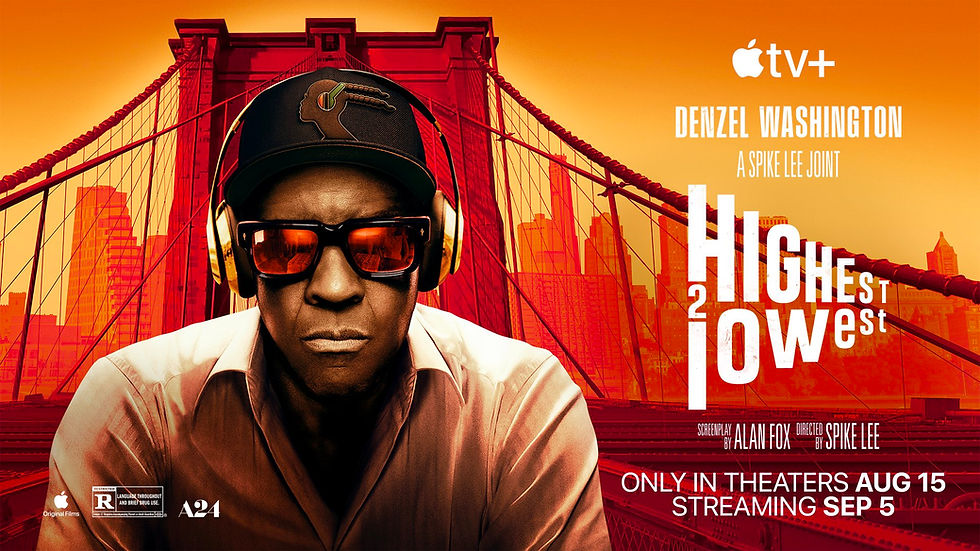Nope Review
- Louis Saddler
- Jul 22, 2022
- 3 min read

After just two films, the work of Jordan Peele stands in a space usually reserved for Marvel films among Hollywood's most anticipated releases, and rightfully so. His first film, Get Out, was instantly hailed as an instant classic due to its unique horror and social commentary mix. His follow-up, Us, wasn’t initially as revered by audiences, but it aged remarkably well to the point where cinephiles continuously revisit Lupita Nyong’o’s performance and place it among the most significant recent Oscar snubs.
For his next act, Peele reunites with his Get Out star Daniel Kaluuya to bring us Nope. Nope is the story of a brother and sister horse caretaking team, O.J. and Em Haywood (played by Kaluuya and Keke Palmer, respectively), who encounter a mysterious force and attempt to capture video evidence of it to sell for big money.
Peele exceeded expectations in his debut, and he avoided the sophomore jinx with another home run in his second effort. Does Nope make the third time a charm for Peele?
If horror is what you’re looking for, Nope ain’t it, and that’s ok because it’s still another outstanding addition to Peele’s body of work. He uses Nope to flex his Spielbergesque muscles and create something that looks more like Close Encounters of the Third Kind than the earlier Peele films.
That’s not to say there’s a stark difference because all of the usual aesthetics are in place. Peele still uses cuts, sound, and camera angles to build suspense and move the story, albeit on a larger scale this go-around. The biting social commentary (this time focusing primarily on spectacles) and historical easter eggs (the connection between Black people and horses, among many others) also remain.
The difference is that Peele takes much longer than usual to get where he’s trying to go. In Get Out and Us, you had a more straightforward path to understanding precisely who and what the protagonist(s) were facing. Nope is a departure from that as a sizable piece of the movie passes before the viewer has any idea of who/what the force is, with the first act and a lot of the second act barely touching the otherworldly figure O.J. and Em seek to capture on video. It also hops around, flip-flopping between present-day and specific past events that give clues to where we are now.
The wait is agonizing in the moment because you need to know the villain, but it works so well when your patience gets rewarded with a steady but spectacular reveal. It’s a testament to Peele’s mastery of building suspense and keeping things under wraps until the perfect moment.
Sadly, Peele’s slow but flawless execution of building suspense is the cinematic version of the ol’ million-dollar move for a two dollar finish. The third act goes from fitting to absurd to WTF with every progressing minute. It’s not a complete letdown as it does feature some of the best shots in Nope, but Peele is a much better filmmaker than the ending suggests.
On the acting side, Kaluuya and Palmer are magic. Kaluuya continues his on-camera excellence with his most subtle performance to date. In this outing, he doubles down on his ability to dominate scenes with a quiet strength that keeps audiences engaged without his words registering above a moderate tone, precisely what was needed to project the stillness and solitude O.J. is living in after witnessing his father’s death.
Palmer, on the other hand, brings the spark that keeps Nope from being too dark and incorporates much of the comedic element that is signature to Peele’s films. It’s not all jokes and one-liners from Palmer, as some of her most impressive and emotional work in Nope comes in the final act, but she is the perfect partner in crime for the subdued Kaluuya.
It won’t spark conversations like Get Out, nor does it scare as much as Us. However, Nope makes yet another stellar mark on Peele’s short but incredible filmography as a filmmaker. He keeps things fresh by taking a more suspenseful approach with Nope and shows he can expand beyond pure horror. A faulty third act does threaten to sink Nope, but Kaluuya’s and Palmer’s performances are strong enough to keep it afloat.
Viewing Nope in IMAX or a large format screen is recommended due to the film being shot in IMAX and selected scenes expanding on the larger screen, but standard screens should be fine as well.



Comments